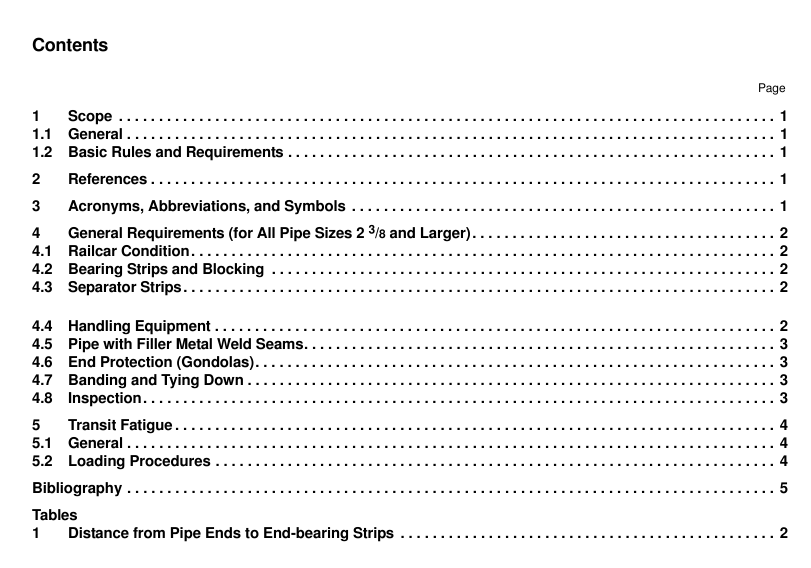API RP 5L1 pdf download

API RP 5L1 pdf download Recommended Practice for Railroad Transportation of Line Pipe
4 General Requirements (for All Pipe Sizes 2 3 / 8 and Larger)
4.1 Railcar Condition Cars used to ship pipe shall be reasonably free of all foreign materials, particularly those of such size and hardness that could damage pipe during shipment by abrasion or that could contribute to movement of the pipe in the car during shipping or humping. Cars that have metallic protrusions on the bed or sides (such as bent or torn parts) that would require excessive thickness of bearing strips or of side stakes to prevent contact of the protrusion with the pipe during shipment shall not be used.
4.2 Bearing Strips and Blocking Metallic bearing strips are prohibited. Side protection shall be provided for pipe shipped in gondola cars where the pipe may contact the sides of the car. Blocking, where required because of uneven car sides, should be introduced between car sides and stakes, and firmly attached to stakes. The thickness of the bearing strips shall be sufficient to prevent the pipe from touching the bed or protrusions thereon, but in no case less than 2 in. (50 mm) nominal thickness and 4 in. (100 mm) nominal width. Furthermore, the following situations shall require 2 in. (50 mm) nominal thickness and 6 in. (150 mm) nominal width for bearing strips, except where AAR stipulates greater dimensions: pipe size ≥ 6 floating loads, and pipe size ≥ 20 in. loads other than floating. Strip height shall not exceed strip width. A minimum of four bearing strips shall be used, and an even number of bearing strips should be used for each pipe stack. Bearing strips shall be evenly spaced. The bearing strips shall be aligned so that the load on individual bearing members is not excessive. All intermediate bearing members should be level with respect to the end bearing members within approximately 1 / 2 in. for pipe of size 6 5 / 8 to size 16 exclusive, and within approximately 1 / 4 in. for pipe of sizes 1 6 and larger or for any pipe having a D/t ratio of 50 or more. The blocking used for leveling shall be firmly attached to the bearing members.
4.3 Separator Strips Horizontal separator strips shall be used when the pipe is not nested. For single or double overhanging loads using separator strips, such strips shall also be used on the overhanging portion, and this portion shall be steel banded, regardless of the D/t ratio. Overhanging shall meet the requirements of Table 1.
4.4 Handling Equipment When end hooks are used for handling pipe, they shall be designed to prevent end damage and should be lined in the area of land (bevel face) contact with a cushioning material (i.e. a nonmetallic material such as rubber or a metallic material such as aluminum, but brass, copper, bronze, and any copper alloy shall be excluded). They shall also have sufficient width and depth to fit the internal curvature of the pipe. Elastomeric aprons shall be attached to pipe hooks to protect the pipe ends unless pipe ends are provided with adequate end protectors. Lifting shall be carried out in such a manner that impact loads sufficient to cause local denting or out-of-roundness of pipe body or pipe ends will not occur. When the pipe is handled by loose lifts, all necessary precautions should be taken during handling to prevent pipe damage, and consideration should be given to selection of slings that will prevent surface damage. Where fork lifts are used, the fork ends shall be rounded or properly padded to minimize damage to the pipe.
4.5 Pipe with Filler Metal Weld Seams Pipe with filler metal weld seams (SAW and GMAW) shall be positioned or padded in such a manner that the weld does not contact either the blocking or the adjacent pipe. When horizontal stripping is used for straight filler metal weld seam pipe (SAW and GMAW), the weld seam shall be positioned at 45°, ± 5°, from vertical. Pipe with a straight filler metal weld seam (SAW and GMAW) shall be positioned with the seam at 0 ° or 1 80 ° (in other words, 12 or 6 o’clock position) when nested, in order to prevent pipe-to-weld seam contact. Furthermore, weld seams should be oriented to avoid contact with steel banding straps.









